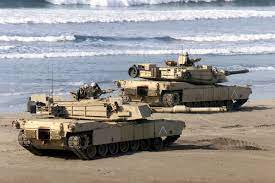
Information from Ukraine indicates the presence of the M1A1 Abrams tank, a U.S. military vehicle, in the area around Kupiansk. This assertion is backed by an image that allegedly originates from the same location. Although the image itself does not provide conclusive evidence, it is entirely feasible that the Ukrainian military has deployed the U.S.-supplied M1A1 Abrams to the front lines.
Russian sources have neither confirmed nor refuted the supposed “tank sighting in Kupiansk,” leaving the situation open to interpretation. Boris Rozhin, a Russian blogger, suggests that if the rumor is substantiated, it could trigger an intense search for American tanks.
Rozhin further elaborates in his Telegram post about the Russian military’s readiness to engage these American tanks in combat, given their alleged intention to breach Russian defenses. He quotes Ukrainian sources, stating, “Abrams emerged from the forest, presumably en route to Kupiansk. The hunt commences.”
In late September, Kyiv received 31 M1A1 Abrams tanks. Post-delivery, there was a significant silence regarding their whereabouts. Foreign experts conjectured that the Ukrainian Armed Forces leadership might have decided against deploying these American tanks to the front lines due to their subpar performance in winter warfare. The prevailing belief was that these powerful machines were being reserved for a spring counteroffensive, allegedly being planned by Zelensky.
However, the Ukrainian generals might have chosen to deploy the Abrams in combat at Kupiansk in response to the difficult circumstances currently faced by the Ukrainian armed forces. With immense pressure from Russian troops and scarce reinforcements, this decision could be a strategic move. However, the current weather conditions are rainy, and the fields are nearly impassable, causing many lighter armored vehicles, regardless of their origin, to get stuck in the muddy fields.
When it comes to the M1A1 Abrams tank operating in the Ukrainian winter, many experts often state, “The Abrams is not winter-ready.” But what does this statement truly imply? It’s important to clarify that all parts of the Abrams tank continue to function even at temperatures as low as -20 degrees Celsius. The real issue with the Abrams lies in its maneuverability.
Similar to how car tires struggle on snowy and icy roads, the M1A1 Abrams tank faces a comparable challenge. It relies on rubber track pads for traction and noise reduction. However, these rubber track pads can lose grip when traversing icy, hilly terrain, akin to car tires skidding on winter roads.
There is a solution to this problem. As per historical accounts and references from those who have had “winter encounters with the Abrams,” a specific winter kit is incorporated into the tank. In simpler terms, the Abrams utilizes “ice cleats” or “winter wedges,” which provide the tank with better grip and enable movement on icy, sloped terrains.
Ice cleats, essentially steel plates with a central, X-shaped cleat bolted to the bottom, are an excellent substitute for the standard rubber padding. They are installed on every fifth shoe of a tank track. Each tank uses two sets of these cleats, totaling 64 individual pieces, to improve traction during the cold winter months.
However, the metal in ice wedges can break under extremely low temperatures. A notable example of this occurred in 1986 during tests with the M1A1 Abrams in South Korea.




